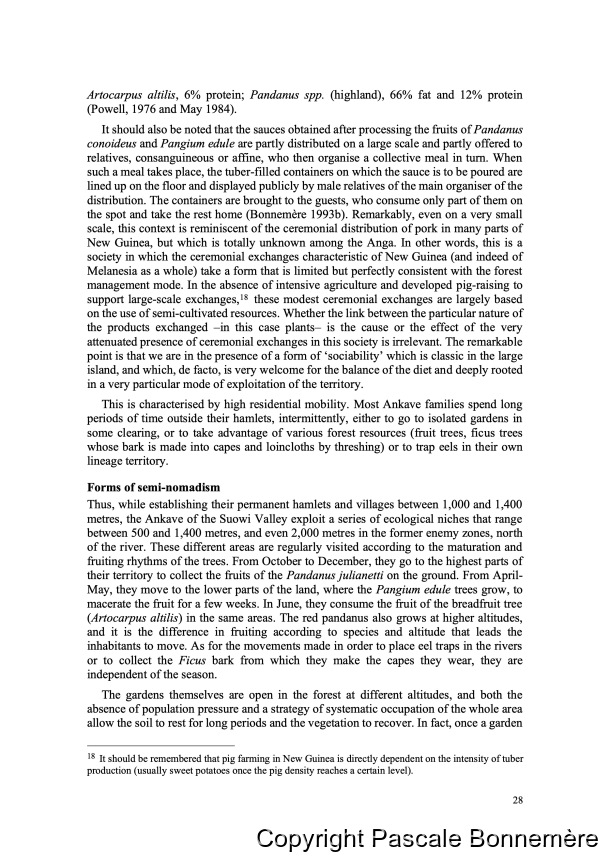|
|  [Note: this transcription was produced by an automatic OCR engine]
Artocarpus altilis, 6% protein; Pandanus spp. (highland), 66% fat and 12% protein
(Powell, 1976 and May 1984).
It should also be noted that the sauces obtained after processing the fruits of Pandanus
conoïideus and Pangium edule are partly distributed on a large scale and partly offered to
relatives, consanguineous or affine, who then organise a collective meal in turn. When
such a meal takes place, the tuber-filled containers on which the sauce is to be poured are
lined up on the floor and displayed publicly by male relatives of the main organiser of the
distribution. The containers are brought to the guests, who consume only part of them on
the spot and take the rest home (Bonnemère 1993b). Remarkably, even on a very small
scale, this context is reminiscent of the ceremonial distribution of pork in many parts of
New Guinea, but which is totally unknown among the Anga. In other words, this is a
society in which the ceremonial exchanges characteristic of New Guinea (and indeed of
Melanesia as a whole) take a form that is limited but perfectly consistent with the forest
management mode. In the absence of intensive agriculture and developed pig-raising to
support large-scale exchanges,!8 these modest ceremonial exchanges are largely based
on the use of semi-cultivated resources. Whether the link between the particular nature of
the products exchanged —in this case plants- is the cause or the effect of the very
attenuated presence of ceremonial exchanges in this society is irrelevant. The remarkable
point is that we are in the presence of a form of ‘sociability” which is classic in the large
island, and which, de facto, is very welcome for the balance of the diet and deeply rooted
in a very particular mode of exploitation of the territory.
This is characterised by high residential mobility. Most Ankave families spend long
periods of time outside their hamlets, intermittently, either to go to isolated gardens in
some clearing, or to take advantage of various forest resources (fruit trees, ficus trees
whose bark is made into capes and loincloths by threshing) or to trap eels in their own
lineage territory.
Forms of semi-nomadism
Thus, while establishing their permanent hamlets and villages between 1,000 and 1,400
metres, the Ankave of the Suowi Valley exploit a series of ecological niches that range
between 500 and 1,400 metres, and even 2,000 metres in the former enemy zones, north
of the river. These different areas are regularly visited according to the maturation and
fruiting rhythms of the trees. From October to December, they go to the highest parts of
their territory to collect the fruits of the Pandanus julianetti on the ground. From April-
May, they move to the lower parts of the land, where the Pangium edule trees grow, to
macerate the fruit for a few weeks. In June, they consume the fruit of the breadfruit tree
(Artocarpus altilis) in the same areas. The red pandanus also grows at higher altitudes,
and it is the difference in fruiting according to species and altitude that leads the
inhabitants to move. As for the movements made in order to place eel traps in the rivers
or to collect the Ficus bark from which they make the capes they wear, they are
independent of the season.
The gardens themselves are open in the forest at different altitudes, and both the
absence of population pressure and a strategy of systematic occupation of the whole area
allow the soil to rest for long periods and the vegetation to recover. In fact, once a garden
18 It should be remembered that pig farming in New Guinea is directly dependent on the intensity of tuber
production (usually sweet potatoes once the pig density reaches a certain level).
28
�
|